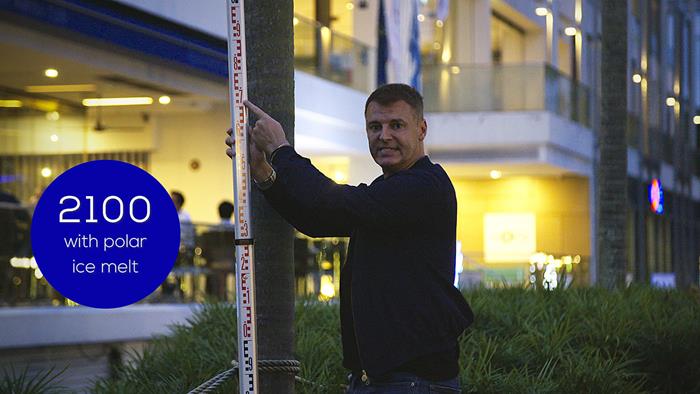In this blog series, scientists from the Earth Observatory of Singapore (EOS) explore key themes of the documentary series Changing Ocean Asia. In this post, Professor Benjamin Horton, Director of EOS, discusses the impact of sea-level rise in Singapore and the region, a theme in the episode 'Engineering Solutions to Higher Sea Levels in Asia' of the documentary series. Watch the episode here.
Sea-level rise poses an existential threat to low-lying coastal nations such as Singapore. It is estimated that 1 billion people (15 per cent of the global population) will be affected by rising seas under high emissions scenarios leading to a 4°C warming.
It is a complex problem that will impact coastal cities in Southeast Asia such as Singapore, Jakarta, or Manila very differently. This is because there are a variety of global, regional, and local processes which drive sea-level rise.

The melting of ice sheets is one of two main global drivers of sea-level rise (Source: Jean-Christophe Andre/Pexels)
Globally, there are two main drivers for sea-level rise. The first driver is the temperature of the ocean. When it increases, the ocean occupies a greater volume and sea level rises. The second driver is the melting of the Greenland and Antarctic ice sheets. Ice sheets more than 10,000 kilometres away from Singapore are melting. While they may be far from us, land-based ice flows into our oceans and leads to an increase in sea level.
In the 20th century, the increase in atmospheric temperatures as a result of greenhouse gas emissions has already raised the global sea level by 20 centimetres (cm). The emissions of the 21st century suggest that global sea levels will increase by a further 30 cm by 2050.
If we do not mitigate the emissions of greenhouse gases by the end of this century, our seas will rise approximately one metre (m). In addition, scientists are exceedingly worried about the Antarctic ice sheet – it is a threat to low-lying nations like Singapore because it holds a colossal amount of water within it. The Antarctic ice sheet is a huge reservoir of water, which could raise sea levels by more than 65 m. If just a small percentage of it melts, it would already have a devastating impact.

Professor Benjamin Horton showing how high sea level could rise by 2100 (Source: Liz Courtney)
The scientific community has estimated what the sea level will be in the future if we destabilise that ice sheet. For Singapore, this will be 1.7 m by 2100. And as this process will only accelerate, the sea level in Singapore could rise five metres by 2150.
This is a stark reality for Singapore and every island nation on this planet. Our scientific research at the Earth Observatory of Singapore is focused on assisting governments, businesses, and communities in identifying the risks associated with our changing ocean and the key steps required to mitigate and prepare communities for climate impacts across Southeast Asia.
The new documentary series Changing Ocean Asia explores four key themes around the impacts of the changing ocean. Narrated by Dr Sylvia Earle, the documentary also looks at the challenges and solutions that are being explored by scientists at the Earth Observatory of Singapore as well as governments and businesses.
The series can be viewed from any web browser or wifi-enabled device that offers the Curiosity Stream application or on any one of their partner platforms including StarHub TV Channel 422 in Singapore, Amazon Prime, Apple TV, and other partners globally.